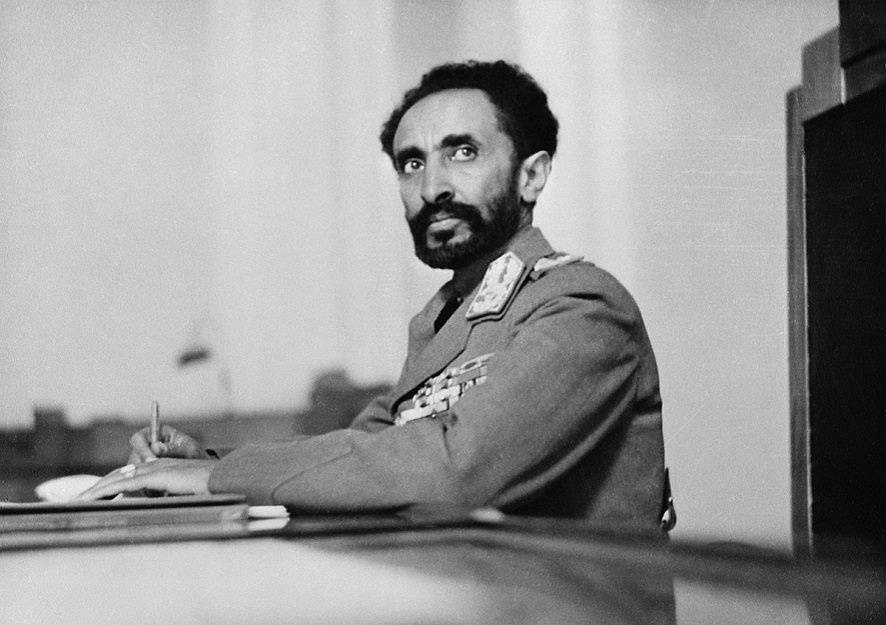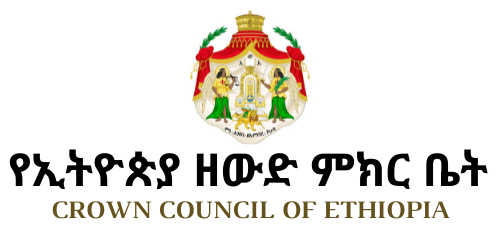A Brief Biography of His Imperial Majesty Emperor Haile Selassie I
23 JULY 1892 - 27 AUGUST 1975

Taken from the book Ethiopia Reaches Her Hand Unto God: Imperial Ethiopia’s Unique Symbols, Structures, and Role in the Modern World, by Gregory Copley.
His Imperial Majesty Emperor Haile Selassie I was born as Lij Tafari Makonnen on July 23, 1892, in the town of Ejarsa Gora in the Harage Province, some 18 miles outside the city of Harar, Ethiopia. Lij Tafari was given the religious name, Haile Selassie. He was the son of Ras Makonnen, Governor of Harar under his kinsman, Emperor Menelik II. Ras Makonnen, a Shoa Amharan noble, was married to an Oromo, Yashimabet, who died two years after Lij Tafari’s birth.1This abridged biography of His Late Majesty Emperor Haile Selassie was based on a variety of sources of published information, including Burke’s Royal Families, Timothy White’s Catch a Fire (a biography of Bob Marley), as well as the Emperor’s biographies (see bibliography), comments from his family members, and so on.
In a significant break with precedence, Lij Tafari Makonnen was raised with an understanding of world affairs, and with an exposure to the outside world. He was to become the first Emperor of Ethiopia to have traveled extensively abroad. Ras Makonnen, and therefore Lij Tafari Makonnen, were directly of the Solomonic Line, as was Emperor Menelik himself and Tafari Makonnen’s great-great grandfather, Negus Sahela Selassie, of Shoa. King Sahela (Sahle) Selassie had already made treaties with foreign states, including Queen Victoria’s Britain.
Lij Tafari Makonnen was, unusually for the period, brought up with both a strong education in Shoan Amharic traditions and in Western history, languages and statecraft. He was named Dejazmatch — literally “keeper of the door”; the equivalent of the title of Count in Western terms — for part of Harage province at the age of 13, in 1904, only about a year before his father’s death.
The governorship of Harar, and the army which went with it, went to another — Tafari’s half-brother, Yelma — when Ras Makonnen died, and Lij Tafari Makonnen was named to the lesser governorship of Selale. But, because of palace politics, he was forced even to administer this governorship from the confines of Emperor Menelik’s palace in Addis Ababa, where he learned first hand the art of political manoeuvre. Emperor Menelik, one of Lij Tafari’s supporters, suffered a severe stroke in 1908, and Tafari was “exiled” to the southern frontier area where he served as governor of Sidamo province. There, however, he had an army of 3,000.
Emperor Menelik had, the year before, designated his 12-year-old grandson, Lij Iyasu, as his heir. Emperor Menelik’s wife, Empress Taitu, promoted the interests of Zauditu, her daughter. At this point, however, Yelma died and the governorship of Harar again became vacant. So in 1910, with the loyalty of the various armies (including Harar) and princes, Tafari, with the Shoa Amharan nobility, was able to insist that Empress Taitu devote her energies to nursing the ailing Emperor, with day-to-day management of the Empire handled by Ras Tasamma as Regent. Ras Tasamma was one of the most powerful rases, commanding an extensive army of his own; he had been the traditional advisor-guardian to Lij Iyasu.
But Tasamma died in 1911, and Lij Iyasu began a determined bid for the throne. Emperor Menelik died in 1913, but Iyasu still could not be crowned: his apparent conversion to Islam, the religion into which his father was born, discredited him in the eyes of the monophysite Ethiopian Orthodox Church and the Shoan nobles. In 1916, they confirmed Zauditu as Empress and the 25-year-old Ras Tafari as “Supreme Regent and Heir Apparent (Crown Prince)”. He was to remain Regent for the next 13 years, a period during which — as de facto ruler of Ethiopia — he began the transformation of Ethiopia into a modern state, in the international sense.
Lij Iyasu attempted during this period to press his claim to the Throne and was arrested in 1921, and died 12 years later.
Empress Zauditu had, in response to the growing power and popularity of the Regent and Crown Prince, crowned Ras Tafari as Negus (king) on September 7, 1928 (Meskarem 27, 1921, in the Ethiopian calendar). It was the first occasion that an Emperor (or ruling Empress) had granted the title of Negus in the Ethiopian context; previously the title Negus had been used only by the kings of the constituent states of Ethiopia (such as the Negus of Shoa, etc.).
Empress Zauditu, herself resentful of the growing popularity of the Regent, in 1930 “sent her husband’s sizable army against Tafari’s forces, but the army was immediately crushed and her husband killed”.2White, Timothy: Catch a Fire. But on April 2, two days after Negus Tafari’s victory against her husband, Empress Zauditu died.
As Regent and Negus, Ras Tafari had undertaken the modernization of Ethiopia on a significant scale, bringing the country into the League of Nations in 1923 (the application had been lodged in 1919), abolishing slavery (in 1923, the trigger to admission into the League of Nations), creating schools and universities, and generally began the development of a modern national infrastructure.
The sudden death of Empress Zauditu led to the coronation of Negus Tafari as Emperor on November 2, 1930 (Tekent 23, 1922, in the Ethiopian calendar), and his elevation to the highest Throne — for which he adopted the Throne name Haile Selassie I — was the cause for a further consolidation of his programme of reforms.
He founded the Bank of Ethiopia in 1931, and encouraged the creation of newspapers.
Throughout this period, however, there were mounting tensions with Italy, which had occupied Eritrea from the 1890s. This flared into open conflict in September 1935, although the League of Nations exonerated both states. This gave confidence to Italian leader Benito Mussolini, who ordered a full invasion of Ethiopia. This time, still conscious of their defeat at the hands of Menelik’s army in the 1896 Battle of Adwa, only 40 years before, the Italians pushed forward with massive resources and an extensive use of chemical weapons. By May 2, 1936, Emperor Haile Selassie was forced into exile and in June he went before the League of Nations in Geneva to call international attention to the plight of Ethiopia.
It was this speech which both drew Ethiopia to the center-stage of world politics for the first time and at the same time highlighted the impotence of the League of Nations. But World War II was to prove Italy’s undoing in Ethiopia and elsewhere. When Italy joined the Axis powers in June 1940, Britain began working with Haile Selassie to remove the Italian forces from Ethiopia. The Emperor moved to the Sudan, with his son, Crown Prince Asfa Wossen (later Emperor Amha Selassie I), to coordinate action between his own troops and those of the British. And with an Army of British, South African, Ethiopian and other African forces, Emperor Haile Selassie re-entered Addis Ababa on May 5, 1941. Fighting, however, continued on Ethiopian soil until January 1942.
With the end of World War II, the Emperor brought Ethiopia into the United Nations as a founding member, and greatly expanded the country’s diplomatic relations. Domestically, he established a new, central judiciary, and ensured that the new, post-war Government was filled with educated ministers with more specific powers. The new judiciary had the task of appointing its own judges, removing them from the hint of political preference.
By 1955, Haile Selassie was ready to introduce the new national Constitution. It was created through a consensus of input from an Ethiopian educated class which had never before been seen in the country and which was, to a great extent, created by the international exposure many Ethiopians had received because of the war.
To a great extent in the post-war era, Ethiopia enjoyed an unprecedented period of relatively uninterrupted stability and progress. It was, therefore, something of a surprise when a coup d’etat was attempted in Addis Ababa on December 13, 1960, whilst the Emperor was abroad in Brazil on a diplomatic mission. While initially appearing to be successful, the coup by the Imperial Bodyguard, the police chief and some radical intellectuals, lacked public support. The Emperor, on hearing word of the coup attempt, flew immediately to Monrovia, Liberia, and then on to Ft. Lamy (now N’djamena, capital of Chad), and thence — despite engine trouble on his DC-6 aircraft — on to Asmara, Eritrea. There, his son-in-law, Gen. Abiye Abebe, was Governor. And with the Emperor’s final return to Ethiopia, the coup was all but over. It collapsed completely on December 16.
The Army and Air Force, and the Church, had remained loyal to the Emperor, but the incident polarized some elements of the society.
Attempts at land reform through changes in the tax system failed in Parliament in 1966 because of the grip on Parliament — and society — by landowners. And the years leading up to 1974 were replete with mounting inflation, corruption and famine.
Some elements of the Army mutinied on January 12, 1974, and several provinces fell into the hands of mutineers in February. By early June, the mutineers had formed a 120-man Dergue (committee), initially claiming allegiance to the Emperor. But they soon began arresting older politicians and nobles connected with the old order, and in July 1974 demanded a new constitution.
The Dergue seized the Emperor on September 12, 1974, and embarked on a reign of terror not dissimilar to the terror of the Robespierre-controlled First Republic in France in the late 18th Century. Civil war ensued, but the Emperor died in August 1975 as a result of massive torturing.3Prouty, Chris, and Rosenfield, Eugene: Historical Dictionary of Ethiopia. London, 1982: The Scarecrow Press. He was buried in a secret grave, but, when the Dergue was finally toppled and the grave found, it was discovered that virtually every bone in his body had been broken by his tormentors.


